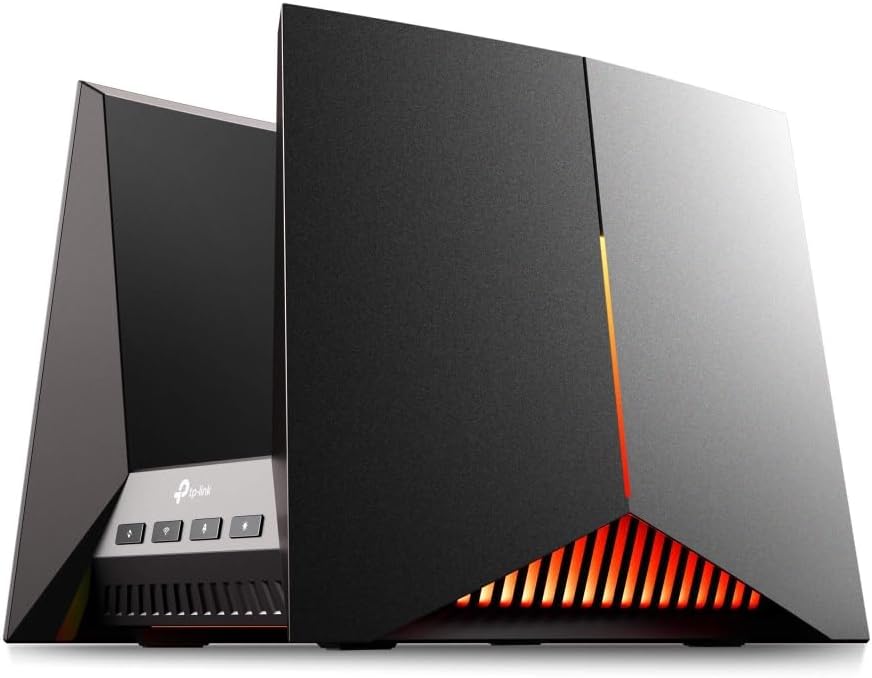The TP-Link Archer GE800 gaming router is designed to meet the needs of serious gamers and demanding network users. It’s one of the first routers supporting Wi-Fi 7, promising significant speed boosts and better stability compared to previous generations. But does it deliver on its promises? Let’s look closely at what this router offers, how it performs in real-world tests, and what actual users are saying about their experience.
First, the router’s design is striking. It features two prominent vertical wings with eight hidden antennas. There’s also customizable RGB lighting. The design clearly targets gamers who appreciate bold aesthetics. But if you’re planning to put it in a living room or office, its size and lighting might feel out of place.
Underneath the eye-catching exterior, the Archer GE800 packs impressive hardware. It supports tri-band Wi-Fi 7, offering theoretical speeds up to 11,528 Mbps on the 6 GHz band, 5,764 Mbps on the 5 GHz band, and 1,376 Mbps on the 2.4 GHz band. These numbers suggest huge performance gains, especially on the newest 6 GHz band. Actual speeds depend on your setup, environment, and client devices, but tests confirm that performance is excellent, with some users reporting speeds above 2,500 Mbps at close range on the 6 GHz band.
One standout feature is Multi-Link Operation. This allows compatible Wi-Fi 7 devices to connect simultaneously to multiple bands, significantly improving connection stability and speed. Users confirm this works well, providing noticeably smoother online gaming and streaming experiences.
On the wired side, connectivity options are robust. There are two high-speed 10 Gbps ports that can function either as WAN or LAN, allowing flexibility if your internet service supports multi-gigabit speeds. Additionally, there are four 2.5 Gbps LAN ports, ideal for gaming consoles, desktops, and NAS devices. There’s even an SFP+ port, providing fiber connectivity if your network setup demands it. Plus, a USB 3.0 port offers convenient file and media sharing options.
Real-world testing of the Archer GE800’s wired performance consistently yields excellent results. Transfer speeds exceed 2.3 Gbps when tested with NAS devices or SSD storage, making it a great choice for heavy data users or anyone regularly transferring large files across their local network.
Coverage is another crucial factor, and the Archer GE800 does well here too. Users typically report stable coverage of about 3,600 square feet, roughly equating to a radius of 105 feet in open spaces. This coverage suits larger homes and multi-story buildings. However, there’s an important caveat—due to the lack of Automated Frequency Coordination (AFC) support at the moment, the 6 GHz band’s range is limited, especially when dealing with multiple walls. TP-Link plans to address this issue with a firmware update, but as of now, placement is critical to ensure optimal performance.
Gaming-specific features further enhance the GE800‘s appeal. A dedicated gaming LAN port automatically prioritizes traffic from connected gaming devices, reducing lag and maintaining stable ping rates during competitive play. Built-in game acceleration tools like Quality of Service (QoS) and WTFast GPN routing significantly cut latency and improve overall responsiveness in online games. Additionally, the Game Panel software provides detailed network stats, ping monitoring, and allows users to prioritize devices manually.
Real-world feedback from gamers consistently praises these gaming enhancements. One verified user mentioned how the Archer GE800 completely eliminated persistent packet burst issues experienced in Call of Duty: Modern Warfare 2. Another noted a substantial improvement in ping stability, making previously laggy gameplay sessions smooth and responsive. Reviews from professional tech sites also echo these positive sentiments, highlighting excellent value considering its feature set and performance.
Yet, there are a few trade-offs to consider. The router incorporates an internal cooling fan, essential for maintaining performance under heavy loads. But this fan runs constantly, creating a noticeable hum. Several users have flagged the fan’s noise as distracting, especially if placed in quiet rooms or bedrooms. Additionally, the router does run warm, though this hasn’t led to reported overheating issues.
The Archer GE800 offers basic security features through TP-Link’s HomeShield service at no additional cost. However, more advanced security options like robust parental controls, detailed reporting, and enhanced intrusion prevention require a subscription to HomeShield Pro.
Setting up the GE800 is straightforward. Users can choose between a simple web interface or TP-Link’s intuitive Tether app. The app simplifies network management tasks, such as device prioritization, parental controls, guest network management, and firmware updates. Setup typically takes less than 15 minutes, even for users less familiar with advanced network settings.
Who should seriously consider buying the Archer GE800? If your household has or plans to adopt Wi-Fi 7 devices, or if you demand reliable, low-latency connections for competitive gaming, this router fits perfectly. Its multi-gig wired connectivity also makes it ideal if you’re lucky enough to have access to multi-gig internet services or regularly use NAS setups.
Overall, the TP-Link Archer GE800 is impressive. It offers cutting-edge Wi-Fi 7 technology, top-tier wired connectivity, and effective gaming enhancements. However, the fan noise, current limitations on 6 GHz range, and subscription-based advanced security features are considerations buyers should weigh carefully. But if gaming performance, future-proof connectivity, and robust wired networking are priorities, this router genuinely delivers.

Low-latency connections for competitive gaming.
